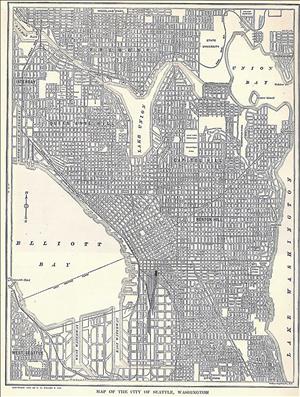On June 18, 1901, Seattle residents organize the Renton Hill Community Improvement Club. The neighborhood is an exclusive residential district in the vicinity of 18th Avenue and Madison Street. Members are concerned about dusty streets and obtaining fire alarm boxes, concrete sidewalks, water mains, school improvements, and trees to beautify the district. Reuben W. Jones is the first secretary.
Tradition held that the community club movement originated when two residents of the North End fell into a puddle of water one dark night. They asked city officials for a street light, to no avail. One of the men was a printer and he created some letterhead stationery with the name of an imaginary community club. He listed himself as the president and the other resident as the secretary. On behalf of the club, they demanded a streetlight. The light appeared within a week. The printer shared his secret with others.
Later in 1901, several other community clubs formed. Five of the earliest clubs organized the Federated Improvement Clubs. The federated clubs were able to place their members on the parks board and increase taxes to pay for parks. In 1907, the federated clubs started the Greater Seattle Movement to lobby and campaign for annexation of new territories into Seattle.
In 1903, the Renton Hill club built a clubhouse on 18th Avenue near Madison Street (on First Hill) on property donated by the heirs of lumberman and merchant Captain William Renton (1818-1891). Other issues of concern to members were the erection of numerous billboards and damage to shade trees by vandals and horses.
The Renton Hill club prospered for 12 years until the district began to change. Residents moved to newer sections of the city and old mansions were transformed into rooming houses. In 1918, the club dissolved and the clubhouse was sold.
The community club movement continued to grow in Seattle. In 1911, Seattle changed its charter and city council members were elected at large instead of from individual wards. This left sections of the city without specific representation. Community clubs and improvement clubs formed to promote the interests of individual neighborhoods. The number of clubs tripled between World War I and 1929. In 1929 there were 79 clubs within Seattle city limits, and another 29 in adjoining suburban neighborhoods.
In the 1920s, the federated clubs organization evolved into separate district federations.

